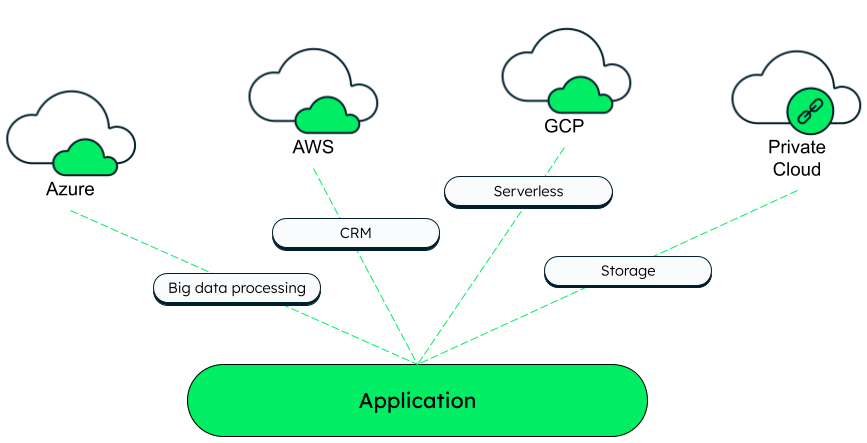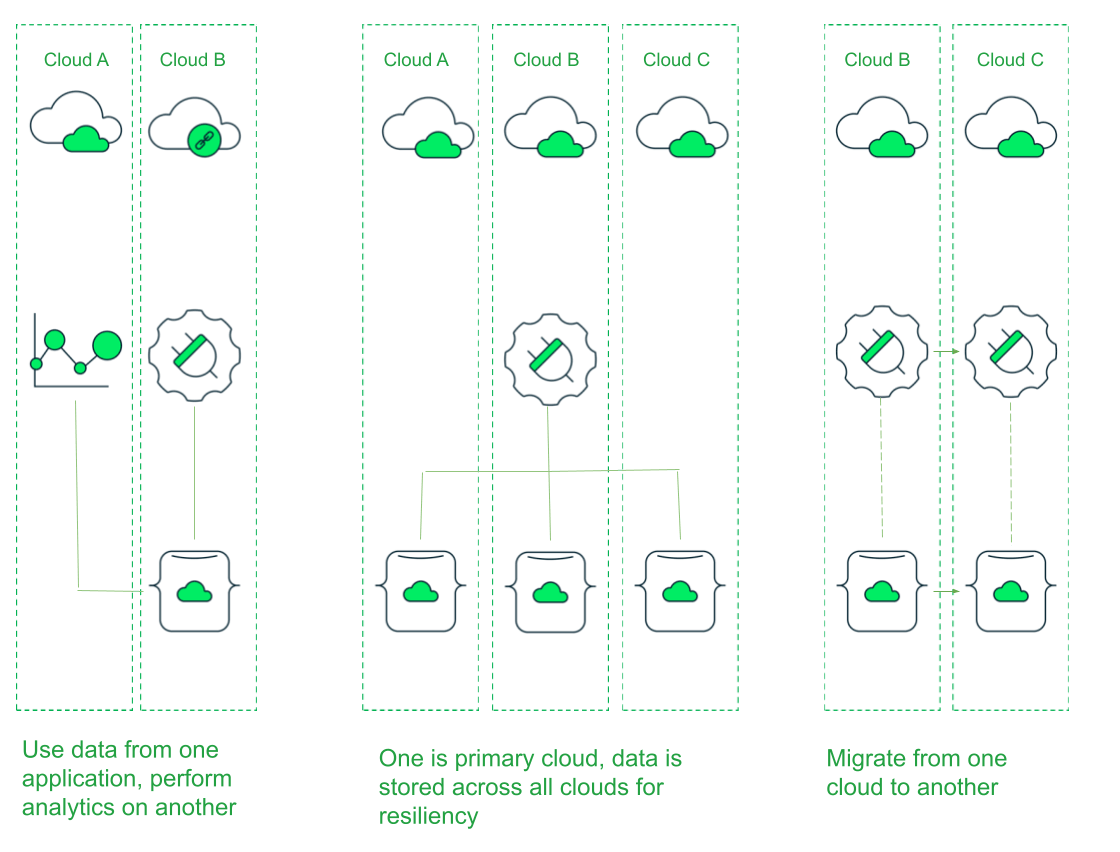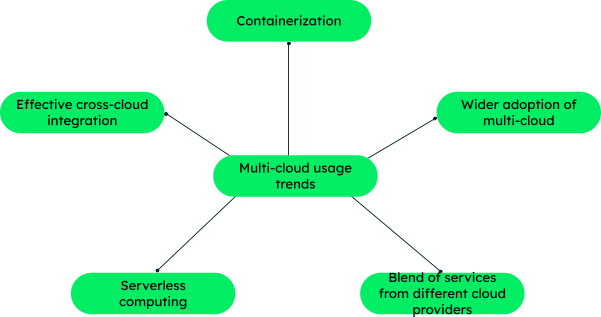Simply explained, multi-cloud is an IT strategy where organizations use a combination of public, private, and hybrid clouds from different cloud providers like AWS (Amazon Web Services), Azure, Google Cloud, IBM Cloud, and many similar providers.

Multi-cloud clusters in MongoDB Atlas, our globally distributed developer data platform, take the concept a step further by enabling a single application to use multiple clouds simultaneously. With multi-cloud clusters, data is easily distributed across different public clouds, like Amazon Web Services (AWS), Google Cloud Platform (GCP), and Microsoft Azure, enabling data mobility and resilience without the complexity of manual data replication.

With a multi-cloud cluster in MongoDB Atlas, you can:
- Use data from an application running in a single cloud and analyze that data on another cloud without manually managing data movement.
- Use data stored in different clouds to power a single application.
- Easily migrate an application from one cloud provider to another.
Importance of multi-cloud
No one cloud infrastructure delivers all things to all people. Cloud vendors offer different blends of service-level agreements, availability, security architectures, pricing, tools, and resources for various needs. An increasing number of enterprises will cherry-pick among the various vendors to find the best combination of features for each specific workload. Multi-cloud is increasingly prevalent for the following reasons:
Tackle Cloud Concentration Risk
Experts across the globe are increasingly focused on cloud concentration risk, or the potential peril created when so much of the technology relies on so few large cloud service providers. This is especially true for the finance industry, where an outage or cyberattack could derail the global financial system.
Several MongoDB customers in the financial services sector have already taken steps to mitigate this risk by adopting a true multi-cloud approach, using MongoDB Atlas, and building nodes in a second public cloud provider.
Gain optimal performance for each workload
It's smarter to choose a cloud infrastructure with the best combination of features for each application than to tinker with the workloads themselves: A “lowest common denominator” application will likely shortchange high performance to achieve cloud portability. For example, the best option for a given company may be to use one cloud provider for cloud infrastructure, another for development, and a third for performance tools.
Avoid vendor lock-in
An almost universal driver for multi-cloud adoption is the desire to avoid being confined to any single provider's infrastructure, pricing model, and specialized services.
Minimize failover risk
No single cloud provider is completely immune from outages. Taking a multi-cloud approach, especially one utilizing backup clouds, provides protection from the risk of having a business-critical application become unavailable.
Compliance with data governance rules
Data governance requirements, such as the EU's GDPR, sometimes stipulate that customer data must be held in particular locations. This can require a multi-cloud strategy if your primary cloud does not support all the regions where your customers reside.
Maximize availability and performance
Latency can be minimized by choosing a cloud provider with a presence geographically close to customers. For organizations serving users in multiple regions, a multi-cloud strategy may be the optimal solution.
Reduce exposure to DDoS attacks
Distributing your workloads and traffic among a number of clouds reduces the risk of distributed denial of service (DDoS) threats.
Multi-cloud strategy
In a multi-cloud strategy, organizations use a combination of one or more cloud services, like SaaS (software as a service), IaaS (infrastructure as a service), and PaaS (platform as a service), from multiple cloud providers. Organizations use multi-cloud strategies for many reasons, like preventing data loss and ensuring they get the best price for all the cloud services.
To ensure a good multi-cloud strategy, organizations must invest in the right people and tools. Some of the best practices are:
Evaluate risks and security measures
Before switching to a multi-cloud environment, businesses have to understand the associated complexities and risks. They should have the knowledge of the services they require, the new risks involved, and new security controls that need to be addressed.
Embrace new IT skills
Organizations should adapt new skills and roles like cloud architect, cloud engineers, and product managers. These roles should be certified in their skill set like DevOps, containerization, and domain knowledge of various cloud providers.
Assess existing applications and overall ecosystem
Before going for a multi-cloud strategy, take a detailed survey of your existing inventory — the current technology stack, how the applications fit into the entire ecosystem, and the business value they bring. This will help in smoother transformation and give better insights on the offerings you'd need.
Choose the right integration approach
If your services are going to be on different clouds (private cloud, public cloud, or on-prem), then the integration between them should be solid. For example, using the Kubernetes operator for MongoDB or the MongoDB Kafka connectors can help to manage the integration of services hosted on different clouds. The ultimate goal is to provide a seamless user experience through a combination of apps and infrastructures.
Prioritize data protection and access control
A combination of public cloud and private cloud could pose many security challenges. Multiple authentication mechanisms should be deployed to ensure the desired level of security. Strict user access controls should be defined to protect data and resources.
Consider overall costs of multi-cloud engagement
One of the benefits of a multi-cloud strategy is cost optimization, mainly because of competitive vendor pricing. However, by adding more cloud services, it is easy to lose track of the costs. This can get out of hand at some point. Consider the costs of factors like integration, performance, mitigating risks, and security controls, as well as human experts, while formulating your strategy.
Leverage vendor-specific services based on your architecture
Choose microservices and cloud native services based on your business requirements. Using containers can improve portability. Similarly, native services provided by a cloud provider are easy to scale and faster to develop and deploy; however, they can lead to vendor lock-in.
Multi-cloud usage trends
We are already seeing a rise in multi-cloud and hybrid cloud technologies. About 82% of large organizations are using a multi-cloud approach with roughly 51% hybrid cloud, 21% multiple public cloud, and 10% multiple private clouds. As per Statista reports, 79%-84% of small and medium businesses are expected to adopt multi-cloud by 2023. More organizations are preferring to distribute their workload using multi-cloud and the trend will continue in 2022 as well. Further, container orchestration tooling like Kubernetes and Docker will continue to be the fastest way of deploying and scaling hybrid multi-cloud environments. Cross-cloud integration and serverless computing are some more trends to look for. It will also be interesting to know how companies blend the capabilities provided by various cloud providers to best suit their application requirements.

Important multi-cloud trends to look for in the coming years
Multi-cloud management
Multi-cloud management addresses the challenges of using multi-cloud by providing the right set of tools and infrastructure. IT teams can manage, automate, and monitor any combination of clouds from a single centralized console. Effective multi-cloud management reduces the strain on IT teams, provides them more visibility in monitoring workloads, and helps them enforce consistent security measures across providers.
Multi-cloud benefits
There are several benefits of a multi-cloud system apart from the fact that organizations need not be locked to a particular cloud vendor.
Increased availability and resilience
Effective multi-cloud approach enables seamless mobility of workloads from one environment to another in case of a failure or disaster, thus ensuring high availability. Cloud providers also provide backup recovery capabilities to protect critical business data.
Better analytics and performance
Organizations can create better infrastructure at reduced costs, and develop systems that produce better user experience. They can weigh-in the cost and performance aspects before choosing the vendors for individual business applications.
Automation
By automating multi-cloud management, companies can manage complex workloads and workflows, and integrate DevOps processes. This is because data, infrastructure, and applications can be orchestrated across multiple cloud environments.
Cost management
As organizations have multiple cloud vendors to choose from, they can choose the multiple vendors that offer competitive pricing, customizable capacity, and flexible payment options for different cloud services.
Governance
As per privacy regulations such as CCPA (California Consumer Privacy Act) and GDPR (General Data Protection Regulation), some of the data can be stored only in specific locations due to data security concerns and for effective governance. Organizations can do this through a multi-cloud strategy without the need for on-premise data centers.
Challenges of multi-cloud
The main concern of a multi-cloud strategy is data privacy and security. Organizations have to carefully implement multi-cloud strategies with stringent security measures. Some common challenges of multi-cloud are:
Data privacy and protection
Keeping data scattered across various data centers and cloud environments makes protection and privacy a challenge. To combat this, organizations come up with various access control measures, as well as a robust cloud architecture.
Need for specialized skills for multi-cloud management
If a multi-cloud environment is not managed properly, it can create more complexity and add up to costs. A dedicated role with specific expertise in IT cloud management is necessary for effective multi-cloud management.
Growing need for services
As the number of services keep growing, the capacity requirements also increase. If organizations don't put a proper strategy in place, the cost and complexity of cloud services may quickly go beyond control.
Increased complexity
Security and governance are more complex to handle in a multi-cloud environment. Also, if the right set of products and services are not selected, this may lead to integration, compatibility, and resilience issues.
Integration issues between different environments
Since each cloud platform is different, a good multi-cloud strategy should pose minimal or no integration issues while moving across environments. Containers are a good way to overcome this challenge, as they provide seamless portability between public cloud environments.
Learn more about MongoDB Atlas
MongoDB Atlas is a fully managed, multi-cloud database service that provides global data distribution and mobility across AWS, Azure, and Google Cloud. Try MongoDB Atlas for free today.
FAQ
What is meant by multi-cloud?
Multi-cloud is a strategy where organizations make use of a combination of services provided by different cloud vendors to solve their business purposes. For example, they can use one public cloud from AWS, another from Microsoft Azure, or a mix of public clouds and private clouds (a hybrid cloud approach) from multiple providers.
What is a multi-cloud strategy?
What is a multi-cloud example?
An example of multi-cloud can be two public clouds from multiple public cloud providers, where applications use data from one cloud, while performing analytics on another.